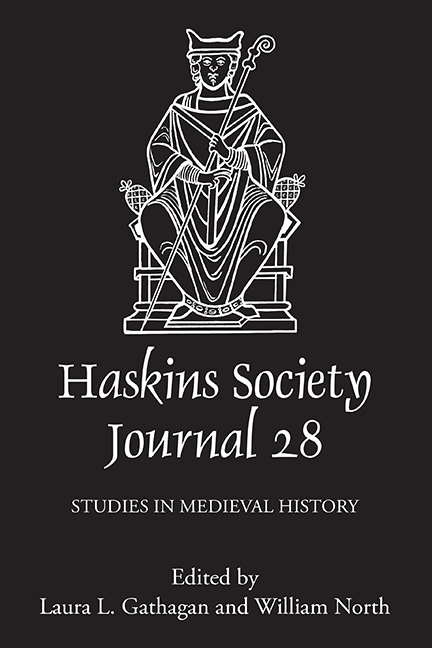Book contents
- Frontmatter
- Contents
- List of Figures and Tables
- Editors' Note
- Abbreviations
- 1 Under the ‘Romans’ or under the Franks? Venice between Two Empires
- 2 Lost and Found: Eadmer's De reliquiis sancti Audoeni as a Cross–Channel Solution to the Canterbury–York Dispute
- 3 Of Lost Libraries and Monastic Memories: Creating the Eleventh-Century Novalesa Miscellany
- 4 The Place of Henry I in English Legal History
- 5 ‘Goliath Thought David Rather Boastful’: Royal Masculinity in Kingless Societies
- 6 Well-Behaved Women? Agnès of Baudement and Agnès of Braine as Female Lords and Patrons of the Premonstratensian Order
- 7 ‘Videmus nunc per speculum’: The Mysticism and Naturalism of the Twelfth-Century imago mundi
- 8 The Norman Kings of Africa?
- 9 Punishing Adultery: Private Violence, Public Honor, Literature, and the Law
2 - Lost and Found: Eadmer's De reliquiis sancti Audoeni as a Cross–Channel Solution to the Canterbury–York Dispute
Published online by Cambridge University Press: 23 August 2019
- Frontmatter
- Contents
- List of Figures and Tables
- Editors' Note
- Abbreviations
- 1 Under the ‘Romans’ or under the Franks? Venice between Two Empires
- 2 Lost and Found: Eadmer's De reliquiis sancti Audoeni as a Cross–Channel Solution to the Canterbury–York Dispute
- 3 Of Lost Libraries and Monastic Memories: Creating the Eleventh-Century Novalesa Miscellany
- 4 The Place of Henry I in English Legal History
- 5 ‘Goliath Thought David Rather Boastful’: Royal Masculinity in Kingless Societies
- 6 Well-Behaved Women? Agnès of Baudement and Agnès of Braine as Female Lords and Patrons of the Premonstratensian Order
- 7 ‘Videmus nunc per speculum’: The Mysticism and Naturalism of the Twelfth-Century imago mundi
- 8 The Norman Kings of Africa?
- 9 Punishing Adultery: Private Violence, Public Honor, Literature, and the Law
Summary
Sometime in the late eleventh century, Eadmer of Canterbury (c. 1060–c. 1130) was sitting in the cloister of Christ Church with book in hand, hard at work, when Osbern of Canterbury (fl. 1080–90) interrupted his study with a story of legend and intrigue. ‘Long ago’, related Osbern, ‘when Lanfranc was still alive, I was investigating the reliquaries of the cathedral, when I came upon one more marvelous than the rest. When I opened this box, it was filled to the brim. Struck by fear, I closed it and left. Now, as if through a dream, I see what that box contained and lest the truth escape us for good, I have come to ask that you and I, accompanied by some sacrists, return to that box and open it.’ Eadmer and Osbern did return to that box and found the remains of a human body, complete except for the bone of one arm. A small scrap of parchment stuffed into the skull was nearly overlooked until one of the sacrists pulled it from the prized relic. It was on this parchment that Eadmer and Osbern read, ‘the relics of saint Audoenus the Confessor’.
Several decades after Eadmer and Osbern discovered the relics of St Ouen, Eadmer recorded the inventio in his De reliquiis sancti Audoeni. In this text, the discovery of Ouen, the seventh-century bishop of Rouen, would work for the Canterbury community in multiple ways. First, it would serve further to connect Canterbury to continental customs and thereby bridge the gap between traditionally Norman and English saints. Second, and most importantly for Eadmer, the discovery of Ouen's relics would help to strengthen Canterbury's claims to primacy over York in a dispute over authority between the archdioceses of Canterbury and York that had persisted since the late eleventh century. Ouen's relics forged a historical and episcopal network between Canterbury and Rouen, two out of three archdioceses in the Anglo-Norman world. It is my aim to show that in De reliquiis Eadmer emphasized this cross-Channel episcopal network in order to promote and preserve his community's prestige.
St Ouen had become well known for his sanctity soon after his death in 684. His cult's primary residence lay within the Benedictine monastery of Saint Ouen in Rouen, which historically held claim to his relics and was one of the most significant abbeys in Normandy.
- Type
- Chapter
- Information
- The Haskins Society JournalStudies in Medieval History, pp. 15 - 38Publisher: Boydell & BrewerPrint publication year: 2017
- 2
- Cited by

